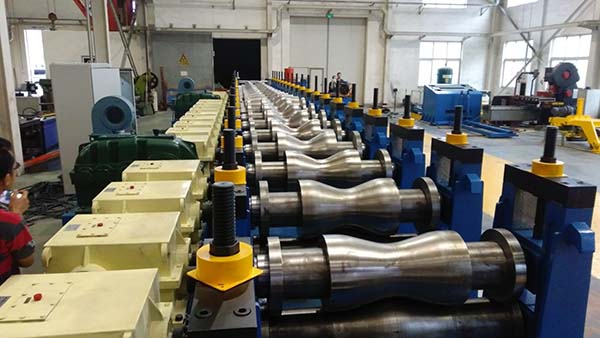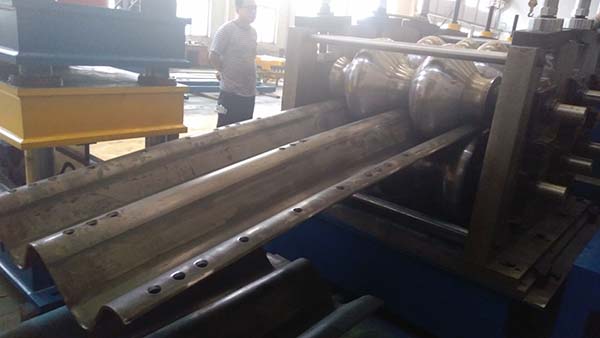Generally speaking, metal processing methods can be divided into cold processing and hot processing. As the name suggests, hot working is the processing of metal profiles after heating, such as hot rolling. On the contrary, the cold working method is mainly the method of processing metal under the lower part, such as traditional milling, milling and grinding. Cold bending processing technology also belongs to cold processing technology. As a processing technology, it has existed for a long time, but it is basically an empirical subject.
Most cold forming techniques are generally used for all metals, but the cold forming method of stainless steel is different from ordinary metals. The main difference is that stainless steel has higher strength and cold work hardening characteristics, followed by cold-worked stainless steel workpieces are also functional and decorative, so it is very important to protect its surface from corrosion. Damage and maintain its anti-rust performance. Therefore, appropriate processes should be used for cold forming of stainless steel.
1. Commonly used stainless steel cold forming technology
In the forming process of stainless steel products, cold rolling technology and hot rolling technology are mainly used. Even cold forming can be achieved in many different ways. The following will briefly introduce some cold forming methods commonly used in the production of stainless steel.
(1) Cold forming
Traditionally, cold bending is widely used to make parts from stainless steel sheet and strip steel. The punch press is basically an open single-acting mechanical or hydraulic drive, and the table length is reduced. This machine can only produce linear parts, but skilled tool designers can also use this machine to produce parts with complex shapes. The length range of the parts produced by the cold bending press is the original type and thickness of stainless steel, the power of the machine and the size of the tools that can be installed. Some large presses, such as the standard 900-ton cold-formed punch press with a length of 11 meters, can produce austenitic stainless steel cold-formed parts with a length of 9m and a thickness of 8.0mm. In order to reduce the wear of stainless steel to the degree of penetration, the tools of the cold bending press are usually made of hot work die steel with a chromium content of 12%, and the plastic film can also be a further protective measure.

It is very economical to use ordinary molds with cold-formed punches to produce small batches of general-purpose parts. However, if special molds are used to produce parts with special shape requirements, large batches are required to reduce mold processing costs and meet their economic benefits. With the development of technology, more and more companies have begun to use cold rolling forming technology to manufacture a large number of parts.
(2) Roll forming
The roll forming method uses a set of continuous frames to roll stainless steel into products with complex shapes, which is suitable for the production of plates and special-shaped wires. The sequence of the rollers is designed according to the principle of gradually deforming the product. The rolling mill adopts automatic control, and the roll profile of each stand can be rolled gradually and continuously until the desired product shape is obtained. If the shape of the component is complex, 36 racks can be used more, but for simple-shaped components, three or four racks are sufficient. Rolls are usually made of cold work die steel, and their hardness is usually higher than HRC62. At the same time, in order to ensure the smoothness of the surface of the workpiece after rolling, the smoothness of the roller surface is also very high.
It is economical to use roll forming technology to produce large numbers of long parts. For a conventional plate rolling mill, the width of the strip that can be processed is 2.5mm to 1500mm, and the thickness is 0.25mm to 3.5mm; for a conventional wire rolling mill, the width of the wire that can be processed is 1mm to 30mm, and the thickness is 0.5mm to 10mm. . The shapes of parts processed by roll forming methods vary from simple planes to complex closed cross-sections.
Generally speaking, due to the high cost of cutting tools, mold processing and equipment, when the monthly output of stainless steel plates exceeds 30,000 meters and the monthly output of stainless steel wires needs to reach more than 1000T. Regardless of the rolling production of the plate or wire, it is necessary to ensure that the surface of the raw material is smooth and clean, and the surface of the mold needs to be checked regularly to prevent surface contamination and scratches, and the equipment also needs to withstand the cold work hardening of stainless steel and high rebound margin. ability.
(3) Stamping and forming
This technology uses punches and molds to produce the desired product shape. Domestic stainless steel stamping and forming production is very common among stainless steel kitchenware manufacturers. Stainless steel basins and basins need to be deep drawn, and the handles of kitchenware also need to be stamped, bent and flattened. The punch can be mechanically driven or hydraulically driven, but use hydraulic transmission as much as possible when deep drawing, because the hydraulic punch can provide full load pressure throughout the stroke range.
Most of the traditional techniques can be used for stamping and forming of stainless steel, but since the force required for stamping stainless steel is more than 60% greater than the force required for stamping mild steel, the frame of the punch press should be able to withstand such a large impact. In addition, it is also very important to solve the problem of scratches, especially when stamping stainless steel, due to high friction and high temperature. Common soaps or lotions are ineffective. Special stamping lubricants or lubricants containing UHV additives should be used. However, since such UHV additives will corrode the surface of stainless steel, the workpiece should be removed after stamping. There are oil stains on the surface.
Due to the high processing cost of stamping dies, stamping technology is only used for mass production.
(4) Rubber gasket molding
The use of rubber gasket molding technology can greatly reduce the processing cost of the mold and can be used to produce small batches of products.
The molding mechanism used in this technology is made of low-cost materials, such as hardwood or reinforced epoxy as a convex mold, and a rubber pad for making a concave mold. The rubber may be a solid rubber block or a layered rubber block, the depth of which is about 30% higher than the molding mechanism. After closing the forming mechanism, the rubber block squeezes the stainless steel blank into a certain shape. When the molding machine is lifted, the rubber pad will recover and the rubber pad can be reused.
The process characteristics of molding with rubber gaskets determine that it cannot be used to produce products with complex shapes, and the greater depth of the parts produced is also limited. This process is usually used to produce small batches of stainless steel parts with a thickness of less than 1.5mm.
(5) Folding forming
As a simple bending machine, the folding machine can be manual or electric. The simple method is to use a model with a bending radius to firmly fix the steel plate on the machine table, and place part of the protruding material on another table that can rotate along the center of the bending radius. When the movable table rises, it bends the stainless steel to the desired angle. Obviously, when bent, stainless steel will slide on the workbench. Therefore, in order to prevent scratches on stainless steel, the surface of the workbench needs to be smooth. In the actual processing process, plastic film is usually used to protect the surface of stainless steel.
The upper beam is usually wedge-shaped to form a gap, so it can be folded into a quadrilateral box or groove with a suitable blank shape. Folding machines have been used to produce large-size and simple stainless steel sheet products, but these products are now more produced by cold bending presses.

(6) Cylinder molding
The bending method is generally used to produce cylinders or cylinders made of thin plates for various purposes.
The traditional rolling mill has a pair of adjustable rollers, which can be adjusted according to the thickness of the steel plate. The third roller, the bending roller, controls the diameter of the forming drum. There is also a variant of this machine, it also uses three rollers, the shape of the roller is the shape of a pagoda. The lower roller is the driving roller, and the upper roller rotates by friction between the upper roller and the workpiece. The diameter of the lower roll is usually half the diameter of the upper roll.
The smaller diameter of the roller produced by the above two equipment is the diameter of the upper roller plus 50mm. The larger diameter of the produced cylinder depends on the size of the feed, the rigidity of the machine and the molded parts, and external support is required in special cases. Support the cylinder.
In real life, the processing method of each product is not single and constant. It usually requires a combination of multiple methods or different processing methods to form a product of the same quality. Therefore, we need to correctly understand and understand the method of stainless steel cold forming, and use it reasonably in life.
2. Common problems and treatment measures in the cold working of stainless steel
(1) Since the surface of the blank to be processed has defects such as dirt, scratches, pits, pitting or thick skin, the processing and deformation of the blank during the cold forming process will magnify these defects, which will directly cause the product to be dirty and unhealthy. Rust, mold scratches, partial product cracking and other phenomena have greatly reduced the yield. Therefore, before the forming process, the surface condition of the blank needs to be carefully checked to ensure that the blank is clean and free of surface defects before processing and production.
(2) The surface of the workpiece is dirty and rusty. After processing, small dents and scratches appear on the surface of the workpiece due to the dirt of the forming mold and the working platform, and the metal chips attached to the surface cannot be removed. timely. In order to avoid this phenomenon, it is necessary to regularly grind and process the mold to ensure the smoothness of its working surface, while keeping the processing equipment and processing workshop clean.
(3) Some forming processes can cause sliding contact between metals. The local high pressure during the forming process will destroy the passive film that protects the stainless steel, and there may be the danger of cold welding the stainless steel surface to the tool surface without a protective layer. When the solder joint breaks in the next sliding, the surface of the tool and mold has been contaminated with debris, which will cause serious scratches on the surface of the stainless steel. This requires ensuring that the molding equipment is in good condition, and at the same time requires the operator to be proficient in the operation process and operate carefully to avoid slippage.
(4) Stainless steel has high strength, and austenitic stainless steel also has obvious cold work hardening characteristics. If the deformation is too large during the cold forming process, it will cause the workpiece to break and even damage the mold and mechanical equipment. . Therefore, during the production process, the hardness of the workpiece should be tested and a reasonable amount of deformation should be maintained to meet the requirements of production efficiency while ensuring product quality.
(5) The passivation film on the surface of the stainless steel workpiece will be destroyed after cold processing. At the same time, it will adhere to the stamping oil, molds and other metal chips, which can easily cause corrosion. In order to make the molded workpiece have good rust resistance and smoothness, it needs to be cleaned, degreasing and passivated. If possible, use plastic film to protect the surface of the workpiece.
With the continuous growth of domestic stainless steel consumption, the application of stainless steel cold forming technology is becoming more and more extensive. We should choose the appropriate molding process according to different product characteristics, and maximize production efficiency while ensuring product quality. Reduce production costs and allow ordinary consumers to buy high-quality and cheap stainless steel products.

Scan mobile station
Jinan Ruifu Mechanical Engineering Co., Ltd.
 Address: No. 686, Songzhuang Industrial Park, Huaiyin Section Store, Jinan City, Shandong Province
Address: No. 686, Songzhuang Industrial Park, Huaiyin Section Store, Jinan City, Shandong Province
 Phone: 0531-87512892/87518718
Phone: 0531-87512892/87518718
 Email: tong1203@163.com
Email: tong1203@163.com